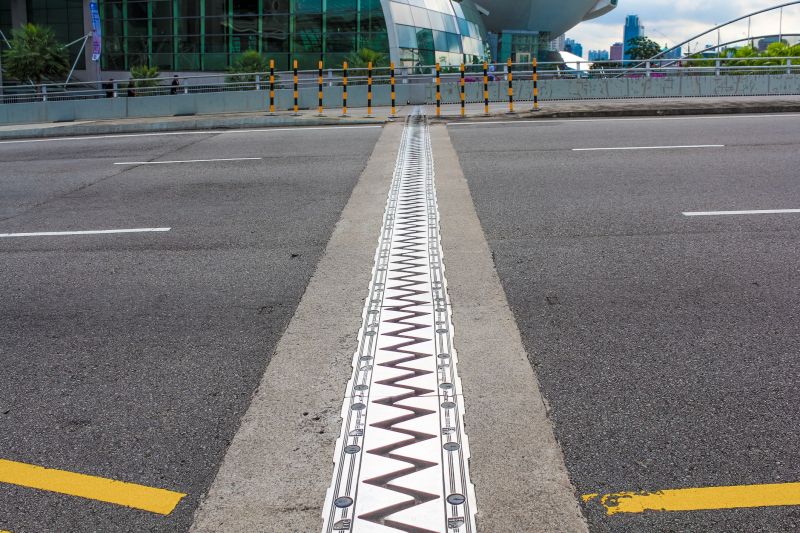Favorite Expansion Joint Replacement Products for Maintenance and Repair
Browse trusted products that simplify replacement tasks and enhance the lifespan of your building joints.
 Expansion joints serve a critical role in accommodating movement and preventing structural damage in various construction applications. They are used in bridges, highways, sidewalks, and industrial flooring to absorb thermal expansion, contraction, and other dynamic forces. Selecting the appropriate replacement products is essential to maintain the integrity and longevity of these structures. Replacement options vary widely, from flexible sealants and rubber profiles to specialized metal and composite materials, each suited to different environmental conditions and load requirements.
Expansion joints serve a critical role in accommodating movement and preventing structural damage in various construction applications. They are used in bridges, highways, sidewalks, and industrial flooring to absorb thermal expansion, contraction, and other dynamic forces. Selecting the appropriate replacement products is essential to maintain the integrity and longevity of these structures. Replacement options vary widely, from flexible sealants and rubber profiles to specialized metal and composite materials, each suited to different environmental conditions and load requirements.
Top Overall Option
Flexible Elastomeric Expansion Joint
A versatile and adaptable solution, flexible elastomeric expansion joints are designed to accommodate a wide range of movements in various structures. They are made from durable rubber compounds that provide excellent elasticity, weather resistance, and longevity. This type of joint can be customized to fit specific dimensions and movement requirements, making it suitable for bridges, pavements, and industrial floors. Proper installation ensures effective performance, helping to absorb thermal expansion and contraction while maintaining structural integrity.
Types of Products For Expansion Joint Replacements
Rubber Profile Expansion Joints
Flexible rubber profiles designed to fit into existing joints, providing sealing and movement absorption for pavements and bridges.
Elastomeric Sealants
High-performance sealants that fill gaps and prevent water infiltration while accommodating movement.
Metal Expansion Joints
Metal-based joints, often made from aluminum or stainless steel, suitable for high-stress environments and heavy loads.
Polyurethane Expansion Joints
Flexible polyurethane materials that offer good elasticity and resistance to weathering, ideal for sidewalks and plazas.
Fiber-Reinforced Joints
Composite joints reinforced with fibers for enhanced strength and durability in industrial applications.
Preformed Foam Expansion Joints
Pre-cut foam materials that expand and conform to joint spaces, providing a cushioning seal.
Bituminous Expansion Joints
Joints coated with bitumen to provide waterproofing and flexibility in roadway applications.
PVC Expansion Joints
Polyvinyl chloride joints offering corrosion resistance and ease of installation for various structures.
Concrete Expansion Joints
Specialized joints designed for concrete pavements and slabs to allow movement without cracking.
Hybrid Composite Joints
Combining different materials to optimize performance and flexibility for complex structural needs.
Popular Choices
Widely used for their flexibility and ease of installation, suitable for various structural applications.
Convenient for quick sealing and filling gaps in expansion joints, offering good adhesion and flexibility.
Flexible metal components that accommodate movement in high-pressure and high-temperature environments.
Used for filling and sealing joints with moderate movement requirements, easy to install.
Sealants formulated to withstand outdoor conditions, providing long-lasting protection for expansion joints.
Gaskets designed to provide a tight seal while accommodating structural movement.
Heavy-duty options designed for industrial floors and high-stress environments.
Profiles made from PVC that combine flexibility with resistance to corrosion and chemicals.
Pre-cut rubber blocks that fit into joint spaces, providing cushioning and sealing.
Adhesive tapes that provide a quick, temporary or permanent seal for expansion joints.
Elastomeric materials designed for extreme conditions, offering excellent flexibility and durability.
When considering expansion joint replacements, it is important to evaluate the physical properties of the materials, such as flexibility, durability, and resistance to weathering. Proper installation ensures that the joints can accommodate movement without failure. Regular maintenance and timely replacements help prevent costly repairs and structural issues. The right product choice depends on factors including the type of structure, expected movement, exposure to elements, and load-bearing needs.
Advancements in material science have introduced a variety of innovative options that enhance performance and longevity. For example, elastomeric compounds provide excellent elasticity, while reinforced rubber profiles offer added strength. Metal-based solutions, such as aluminum or stainless steel, are often used in high-stress environments. Composite materials combine the benefits of multiple substances to deliver tailored solutions for specific applications. Understanding these options can help in selecting a product that best fits the project requirements.
Ultimately, the goal is to find a replacement product that offers reliable performance over time, minimizes maintenance, and adapts to the specific conditions of the installation site. Consulting with industry professionals and referencing manufacturer specifications can aid in making informed decisions. Properly selected and installed expansion joint replacements contribute significantly to the safety, functionality, and durability of infrastructure projects.
Key Buying Considerations
- Material compatibility with the existing structure and environment
- Flexibility and elasticity to accommodate expected movement
- Resistance to weathering, UV exposure, and chemicals
- Load-bearing capacity and structural support requirements
- Ease of installation and compatibility with existing joints
- Durability and expected lifespan of the product
- Waterproofing and sealing capabilities to prevent infiltration
- Temperature range the material can withstand
- Maintenance requirements and ease of replacement
- Compliance with relevant building codes and standards
- Cost-effectiveness over the product's lifespan
- Availability of customization options for specific sizes and shapes
- Compatibility with other joint components or sealants
- Environmental conditions such as exposure to salt or pollutants
- Impact of joint movement magnitude on product selection
